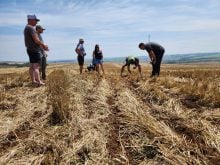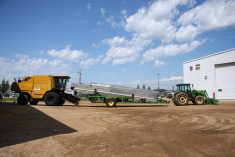SWIFT CURRENT, Sask. – Jim Bessel does not recommend straight combining canola, but the senior agronomist with the Canola Council of Canada says he knows producers are going to do it anyway.
“We know that about 15 percent of you straight combine now,” he told producers attending a field day at the Wheatland Conservation Area in Swift Current.
The practice is common in North Dakota and spreading in Western Canada. It can increase harvested yields but can also increase shattering and pod drop.
Read Also

StatCan stands by its model-based crop forecast
Statistics Canada’s model-based production estimates are under scrutiny, but agency says it is confident in the results.
Those who choose to straight cut need to know what they are up against, Bessel said. Past research at the council’s production centres examined the practice on 50 by 500 foot plots to determine the conditions required to make it work.
“You need to be quite confident that you have a crop that is fairly well knitted,” Bessel said.
The crop should lean together but not lodge. The idea is to stabilize the pods and keep shattering to a minimum. Seed loss will occur, he added, but there are ways to combat it.
Choosing the right header is important. The Biso header from Europe has worked well for most who have used it. The cutter bar can be adjusted ahead of the reel so any seeds that fall land on the pan.
He said while flex headers stick out further, rigid headers are preferable. A five- to eight-centimetre piece of tubing can convert a flex header to rigid.
“Use your pick-up reel as high as you can so (the crop) comes over the cutting bar and onto the table,” he said.
Draper headers also work well.
“Make sure they are sealed well enough so you’re not losing seed before it heads up the combine.”
While some producers choose shorter varieties for this harvest method, Bessel said there is no clear evidence on which works best.
“To me, it’s more environment than variety. It’s more how the crop is standing.”
Bessel also said that while cereals get tough at night, canola is often dry enough to harvest. It will be more pliable, which should help reduce loss.
However, he reminded producers that looking down from the combine at night can cause other problems.
“Safety is the key thing,” he said.
“When you stop you’ll be disoriented.”
Bessel also addressed the issue of pod sealants and whether there is any benefit to using them.
“My background says big question mark. Big, big question mark.”
Sealants such as Pod Ceal are applied by air or with a high-clearance sprayer to help reduce shattering during straight combining.
The main question is whether sealants result in extra profit. Check-off dollars are being used to try the products in Saskatchewan, but that work will only continue if value is shown, he said.
If it does continue, the work will take on a formal research format.
He recommended that producers who use sealants leave a strip without product. The combine yield monitor should be able to show any difference.
“Do your own evaluation,” he said. “It’s not another cheap investment per acre.”
At Regent, North Dakota, seed grower Curt Honeyman has used Pod Ceal for six seasons and feels it has been a good investment.
In his county, 750 kilometres south of Regina, straight cutting of the canola crops is the norm.
“We don’t swath it down here. Too windy, it blows away, or too hot and it cures up too fast after swathing and we get 10 to 15 percent green seeds.”
“We’ve seen a 200 to 400 pound savings (per acre) in yield, based on our own strips (testing),” said the North Dakota farmer.
“This year things might cure more slowly due to the colder season and all the extra moisture we’ve had. But I think I’ll err on the side of safety and apply it again,” he said.

















